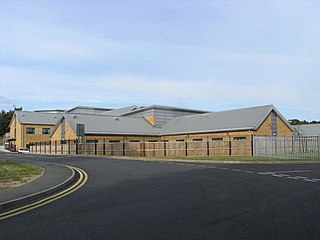
Pediatrics is the branch of medicine that involves the medical care of infants, children, adolescents, and young adults. In the United Kingdom, paediatrics covers many of their youth until the age of 18. The American Academy of Pediatrics recommends people seek pediatric care through the age of 21, but some pediatric subspecialists continue to care for adults up to 25. Worldwide age limits of pediatrics have been trending upward year after year. A medical doctor who specializes in this area is known as a pediatrician, or paediatrician. The word pediatrics and its cognates mean "healer of children," derived from the two Greek words: παῖς and ἰατρός. Pediatricians work in clinics, research centers, universities, general hospitals and children's hospitals, including those who practice pediatric subspecialties.

A children's hospital is a hospital that offers its services exclusively to infants, children, adolescents, and young adults. In certain special cases, they may also treat adults. The number of children's hospitals proliferated in the 20th century, as pediatric medical and surgical specialties separated from internal medicine and adult surgical specialties.

Monash Medical Centre (MMC) is a teaching hospital in Melbourne, Australia. It provides specialist tertiary-level healthcare to the Melbourne's south-east.

The Riley Hospital for Children at Indiana University Health is a nationally ranked freestanding 354-bed, pediatric acute care children's hospital in Indianapolis, Indiana, United States. It is affiliated with the Indiana University School of Medicine. Riley Hospital for Children is a member of the Indiana University Health system, the only children's hospital in the network. The hospital provides comprehensive pediatric specialties and subspecialties to infants, children, teens, and young adults aged 0–21 throughout Indiana and features an ACS verified level I pediatric trauma center. Its regional pediatric intensive-care unit and neonatal intensive care units serve the entire Midwest region. In addition, Riley has two helipads for rapid transport of emergent pediatric care. Riley Hospital for Children is named for James Whitcomb Riley, a writer and poet who lived in Indianapolis.

A mental health trust provides health and social care services for people with mental health disorders in England.
Adolescent medicine also known as adolescent and young adult medicine is a medical subspecialty that focuses on care of patients who are in the adolescent period of development. This period begins at puberty and lasts until growth has stopped, at which time adulthood begins. Typically, patients in this age range will be in the last years of middle school up until college graduation. In developed nations, the psychosocial period of adolescence is extended both by an earlier start, as the onset of puberty begins earlier, and a later end, as patients require more years of education or training before they reach economic independence from their parents.

The National Healthcare Group (NHG) is a group of healthcare institutions in Singapore. The group was formed in 2000 and operates several hospitals, national specialty centres, and polyclinics. Tan Tock Seng Hospital is the largest hospital in the group and serves as the flagship hospital for the cluster.

The Government Medical College, Thiruvananthapuram is in Thiruvananthapuram, India. Founded in 1951, it was inaugurated by Prime Minister Jawaharlal Nehru and is Kerala's first ever Medical College.

Intermountain Primary Children's Hospital (PCH) is a nationally ranked pediatric acute care children's teaching hospital located in Salt Lake City, Utah. The hospital has 289 pediatric beds and is affiliated with the University of Utah School of Medicine. The hospital is a member of Intermountain Healthcare (IHC) and is the only children's hospital in the network. The hospital provides comprehensive pediatric specialties and subspecialties to infants, children, teens, and young adults aged 0–21 throughout the Salt Lake City and outer region. PCH also sometimes treats adults that require pediatric care. PCH is a ACS verified Level 1 Pediatric Trauma Center and is the largest providers of pediatric health services in the state. The hospital serves the states of Utah, Nevada, Idaho, Montana, and Wyoming, yielding an enormous geographic catchment area of approximately 400,000 square miles. The hospital is one of the only pediatric hospitals in the region.
Adolescent health, or youth health, is the range of approaches to preventing, detecting or treating young people's health and well-being.

St. Luke's Hospital is a community hospital in Singapore that provides professional healthcare services. It was named after the patron saint of the medical profession, St Luke. St Luke's Hospital for the Elderly Sick was registered as a voluntary welfare organisation in the Registry of Societies in October 1991. It was renamed to St Luke's Hospital in September 2004 to signify the hospital's role as a community hospital while retaining its focus on geriatric care. The idea of setting up community hospital was first mooted by a group of Christian doctors and nurses after a report from the Advisory Council on the Aged in 1988 raised important issues concerning the lack of adequate elderly care facilities in Singapore. A projection of the number of facilities and resources needed to provide adequate healthcare services to Singapore's ageing population in 2030 revealed serious shortfalls. In response to the problem of inadequate healthcare facilities for the elderly, a group of 8 churches and Christian organisations including the Graduate Christian Fellowship and the Singapore Nurses' Christian Fellowship came together to set up St Luke's Hospital for the Elderly Sick. St Luke's Hospital is headed by a board of directors and various committees that oversee the daily operations of the hospital.

OSF Saint Francis Medical Center, located in Peoria, Illinois, United States, is a teaching hospital for the University of Illinois College of Medicine at Peoria and part of the OSF Healthcare System. The center, which is the largest hospital in the Peoria metropolitan area and in central Illinois, is designated by the state of Illinois as the Level I adult and pediatric regional trauma center for a 26-county region in mid-Illinois.

Healthcare in Belgium is composed of three parts. Firstly there is a primarily publicly funded healthcare and social security service run by the federal government, which organises and regulates healthcare; independent private/public practitioners, university/semi-private hospitals and care institutions. There are a few private hospitals. Secondly is the insurance coverage provided for patients. Finally, industry coverage; which covers the production and distribution of healthcare products for research and development. The primary aspect of this research is done in universities and hospitals.
The Psychiatric Institute of Washington (PIW) is an acute psychiatric hospital in Washington, D.C. Opened in 1967, PIW is a short-term, private hospital. It offers behavioral healthcare to patients with mental and addictive illnesses, including children, adolescents, adults and the elderly. Services offered by PIW include inpatient, partial and intensive outpatient hospitalization, and group treatment programs for substance abuse and addiction.
Puberty blockers, also called puberty inhibitors or hormone blockers, are medicines used to postpone puberty in children. The most commonly used puberty blockers are gonadotropin-releasing hormone (GnRH) agonists, which suppress the production of sex hormones, including testosterone and estrogen. In addition to their various other medical uses, puberty blockers are used for transgender children to delay the development of unwanted sex characteristics, so as to allow transgender youth more time to explore their identity.
Margaret "Peg" Belson, MBE (1921–2012) was a British health care campaigner who made voluntary contributions over 60 years, in the UK and abroad, in the field of children's welfare in hospitals, including the establishment of the Action for Sick Children Association. She was a founding member of the European Association for Children in Hospital (EACH). She was a holder of BA (Syd) and PhD (Hon).
The Platt Report, formerly known as the Welfare of Sick Children in Hospital , was a report that was the result of research into the welfare of children who were undergoing medical treatment within the UK and to make suggestions that could be passed on to the hospital authorities that would improve their welfare during hospital visits. The report was named after Sir Harry Platt, who was the President of the Royal College of Surgeons. Platt produced the report at the behest of the Ministry of Health in the UK government. The recommendations in the Platt Report, provided the means by which a child trauma ward of a hospital should be planned for children. Established on 12 June 1956, the committee that was to produce the report defined their remit as:
To make a special study of the arrangements made in hospitals for the welfare of ill children – as distinct from the medical and nursing treatment – and to make suggestions which could be passed on to hospital authorities.

Forster Green Hospital was a non-acute hospital located in Belfast, Northern Ireland. It offered a range of services including neurology, care of older people, and a child and family centre. The hospital was located on a 47-acre site in South Belfast. It was managed by the Belfast Health and Social Care Trust and closed in 2012. Located within the hospital grounds is the regional child and adolescent mental health inpatients unit, Beechcroft. This opened in 2010. Knockbreda Wellbeing and Treatment centre is also located within the grounds of Forster Green and opened in 2009. This has been described as a "one stop approach" to healthcare as it offers a wide range of healthcare services for the local community including general practice and physiotherapy.
Timothy Brei is a Professor of Neurodevelopmental Pediatrics at the University of Washington and a developmental pediatrician at Seattle Children's Hospital. He is also the medical director of the Spina Bifida Association of America. Brei's research has focused on healthcare outcomes for children with spina bifida and as an adult with spina bifida who is an uncommon leader, he has also served as an advocate.












